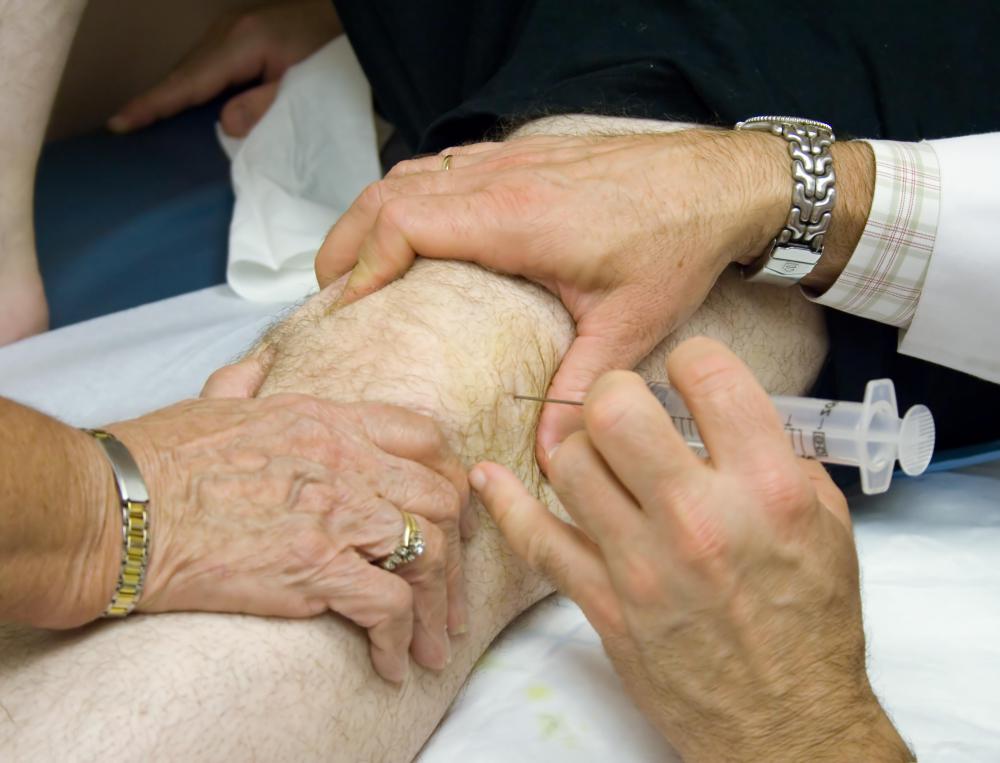At WiseGEEK, we're committed to delivering accurate, trustworthy information. Our expert-authored content is rigorously fact-checked and sourced from credible authorities. Discover how we uphold the highest standards in providing you with reliable knowledge.
How can I Treat Bursitis?
Bursitis refers to swelling or inflammation of one or more bursa, tiny fluid filled pockets that occur between tissues, most often near joints. Commonly when bursitis occurs, likely places for inflammation include the joints, especially the knees, elbows, shoulders, hips, or at small bursas at the base of the toes. Swelling can be the result of injury to the joints, arthritic conditions, or infection, and can be very painful.
Infectious bursitis has quite different treatment standards than does inflammation of the bursas due to injury or arthritis. A physician should immediately evaluate symptoms which include sudden swelling, for example if you scrape the bursa in the front of your knee, signs of wound drainage, scrapes that are hot to the touch, or that have red marks. It is easy for these infections to spread to other parts of the body and create sepsis, and an untreated infection can create significant damage to the tissues the affected bursa is supposed to protect.

In instances where bursitis might be of an infectious nature, you will take antibiotics, which may need to be given through IV (intravenous drip). It may also be necessary to drain the bursa several times. This sometimes requires surgery, though other times drainage is accomplished via needle biopsy. It is extremely important that this condition be addressed immediately, since infected bursa can indicate other serious conditions.

Treatment for bursitis resulting from injury or arthritis may require drainage of the bursa too, but this is less common. Most often, people are advised to rest the joint where the affected bursa is inflamed. It can help to ice the area for about 15-20 minutes every couple of hours to reduce swelling. Occasionally cortisone injections are used to help promote an immediate calm down of the swollen bursa.

Pain medication, especially non-steroidal anti-inflammatories (NSAIDS) like ibuprofen or naproxen sodium can help relieve the condition. When these are not enough on their own to address pain, doctors may also prescribe opiate drugs. These include medications like Vicodin®, Percocet®, Darvon®, and codeine.
If fluid removal is necessary, this is usually done in a doctor’s office, and involves using a needle injected into the bursa to remove fluid. Fluid may be evaluated to be certain that it shows no signs of infection when no defined injury or arthritis is identified as responsible for the condition. Usually this treatment is a last resort, but it can help with immediate relief of bursitis, since draining fluid from the bursa means inflammation is reduced significantly.
AS FEATURED ON:
AS FEATURED ON:

















Discussion Comments
I have just recently had my hip injected with cortisone and it has brought relief from very painful bursitis. I live in Sydney, Australia, so yes of course we do these procedures here!
I fell on my knees two months ago and developed bursitis. Finally went to doctor and had it drained yesterday. Kept it wrapped with an ace bandage. Today it's bigger than before. What's up with that?
Try this: Soak your foot (my bursitis location) with hot/warm water with a bit of salt into the water for about 15 - 30min every day. Works like a charm! Good luck!
Chester
i have had hip bursitis for five years, the pain is unbearable. i have been to three different orthopedic surgeons, and they have all told me there is no cure.
I have seronegative polyarthritis, and some slight hip joint damage. Tried cortisone, anti inflammatories, all sorts of pain killers, none of them worked.
I am now on 50mg duragesic patches, sometimes they work, sometimes they don't. Seems to me they don't remove or drain the bursa in Australia.
i am shaik mohsin & my age is 24. i got bursitis on my left knee joint. i consult with rhematologist. he remove fluid from my knee and inject the injection. then i got relax. i want advice from you that any drug should i take for complete relief from this bursitis? please guide me. i will be thankful to you.
Bursitis on kneecap from banging my knees into something very hard. Bursa developed one month later and I still have it. Size of 1/2 a tennis ball on the kneecap. Dr. says just watch and take Aleve. How long does it take the body to "dissolve" this fluid back into its system naturally?
Post your comments